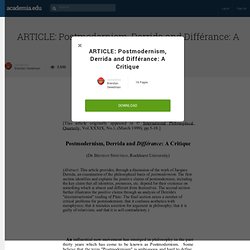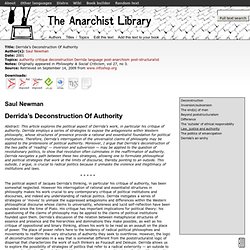

World ancestry. Karl Popper's the Three Worlds of Knowledge. Karl Popper's the Three Worlds of Knowledge "What is the object of knowledge?

" asks young Grasshopper. "There is no object of knowledge," replies the old Shaman, "To know is to be able to operate adequately in an individual or cooperative situation. " "So which is more important, to know or to do? " asks young Grasshopper. One of the more popular epistemology models (except for perhaps in the training/learning/behavioral sciences) is Sir Karl Popper's writings on the Three Worlds of Knowledge. Karl Popper theorizes that there are three worlds of knowledge: World 1 is the physical universe. And of course, there are various relationships between these three worlds: World 1 drives and enables world 2 to exist, while world 2 tries to control and regulate world 1.
Темы научных статей по философии из каталога электронной библиотеки КиберЛенинка. History of Philosophy without any gaps. Branches of science. The scale of the universe mapped to the branches of science and the hierarchy of science The main branches of science (also referred to as "sciences", "scientific fields", or "scientific disciplines") are commonly divided into two major groups: social sciences, which study human behavior and societies, and natural sciences, which study natural phenomena (including fundamental forces and biological life).

These groupings are empirical sciences, which means the knowledge must be based on observable phenomena and be capable of being tested for its validity by other researchers working under the same conditions. In addition to empirical sciences, there are the formal sciences, such as mathematics and logic, which use an a priori, as opposed to factual methodology to study formal systems. These three categories make up the fundamental sciences, on top of which are interdisciplinary and applied science, such as engineering and medicine.
Natural science[edit] Physical science[edit] Physics[edit] Method of loci. The method of loci (loci being Latin for "places") is a method of memory enhancement which uses visualizations with the use of spatial memory, familiar information about one's environment, to quickly and efficiently recall information.

The method of loci is also known as the memory journey, memory palace, or mind palace technique. This method is a mnemonic device adopted in ancient Roman and Greek rhetorical treatises (in the anonymous Rhetorica ad Herennium, Cicero's De Oratore, and Quintilian's Institutio Oratoria). Many memory contest champions claim to use this technique to recall faces, digits, and lists of words. These champions' successes have little to do with brain structure or intelligence, but more to do with using spatial memory[1] and the use of the method of loci. 'the method of loci', an imaginal technique known to the ancient Greeks and Romans and described by Yates (1966) in her book The Art of Memory as well as by Luria (1969).
Contemporary usage[edit] Literature[edit] Outline of science. 10 Scientific Laws and Theories You Really Should Know" The British physicist and novelist C.P.

Snow once said that a nonscientist who didn't know the second law of thermodynamics was like a scientist who had never read Shakespeare [source: Lambert ]. Snow's now-famous statement was meant to emphasize both the importance of thermodynamics and the necessity for nonscientists to learn about it. Thermodynamics is the study of how energy works in a system, whether it's an engine or the Earth's core. It can be reduced to several basic laws, which Snow cleverly summed up as follows [source: Physics Planet ]: You can't win.
Let's unpack these a bit. The second statement -- you can't break even -- means that due to ever-increasing entropy, you can't return to the same energy state. Finally, the third law -- you can't quit the game -- refers to absolute zero, the lowest theoretical temperature possible, measured at zero Kelvin or (minus 273.15 degrees Celsius and minus 459.67 degrees Fahrenheit). (1) ARTICLE: Postmodernism, Derrida and Différance: A Critique. In order to elaborate these points further, it is helpful todistinguish in Derrida's work between two realms, the realm of reality(or of différance.

Derrida’s Deconstruction Of Authority (Saul Newman) Abstract: This article explores the political aspect of Derrida’s work, in particular his critique of authority.

Derrida employs a series of strategies to expose the antagonisms within Western philosophy, whose structures of presence provide a rational and essentialist foundation for political institutions. Therefore, Derrida’s interrogation of the universalist claims of philosophy may be applied to the pretensions of political authority. Moreover, I argue that Derrida’s deconstruction of the two paths of ‘reading’ — inversion and subversion — may be applied to the question of revolutionary politics, to show that revolution often culminates in the reaffirmation of authority. Derrida navigates a path between these two strategies, allowing one to formulate philosophical and political strategies that work at the limits of discourse, thereby pointing to an outside.
Timeline of Philosophy. ПОРЯДОК ДИСКУРСА философия электронная библиотека Новейший философский словарь.